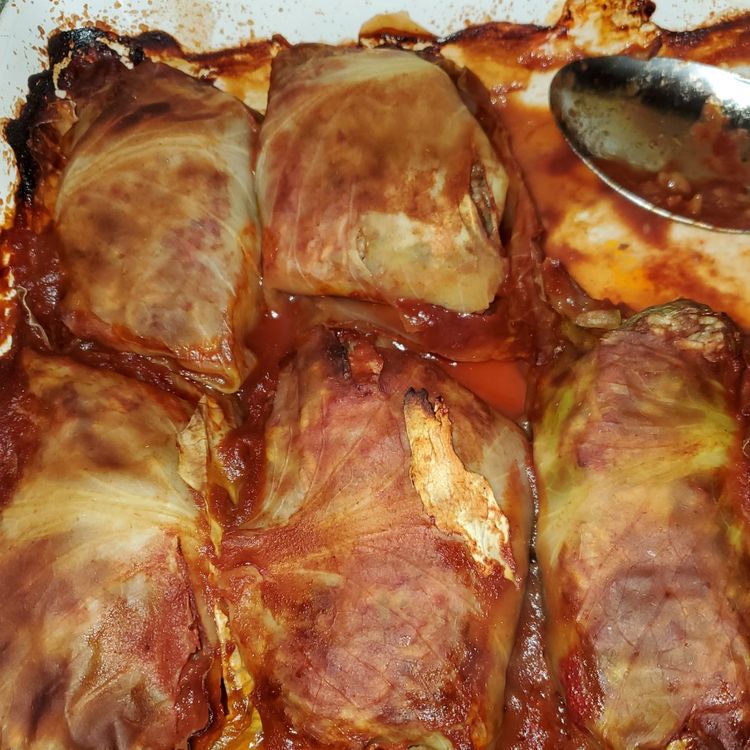Stuffed cabbage is a classic Ashkenazi Jewish dish, and everybody seems to have their favorite way of making it. Also known as holishkes or prokes, stuffed cabbage leaves were a central part of the Eastern European Jewish diet. When we talk about these types of dishes, it nearly always comes down to one question:
“How did Bubbe make it?”
We all have a fondness in our heart for the dishes we grew up with, and the way our parents or grandparents cooked them. Often, we find ourselves wishing that our grandparents had written their family recipes down. After they’re gone, we struggle to capture that traditional flavor, the one we remember so well from our childhood.
Because I don’t have a Jewish “bubbe” (grandma), I have to create my own favorite way of making these iconic Jewish dishes. Sometimes I am influenced by my husband’s family, but I also like to see what other family traditions are out there. Whenever I want to learn a Jewish recipe, I try many, many different recipes to see what I like best in each one. That means I’ve made stuffed cabbage over a dozen different ways. I’ve tried recipes from Polish friends and Israeli friends. I’ve tried it the Sara Kasden way, the Molly Goldberg way, the Fanny Engle and Gertrude Blair way (Jewish cookbook authors from my vintage cookbook collection). I’ve tried the wonderful versions from Joan Nathan and Arthur Schwartz and 2nd Avenue Deli. I’ve made it with V-8 juice and tomato soup, cranberry sauce and apricot preserves, raisins and crushed gingersnaps. They’re all terrific, and each has something that makes it special. My challenge is to take the thing I like best in each recipe and create something new, something fresh– my own take on the classic.
One thing I’ve found is that I like a stuffed cabbage that is less sweet and more tart. Polish versions tend to be extremely sweet, often with raisins. I prefer a tart sauce with a slight sweetness, as well as a savory filling full of flavor. I add sauerkraut for that extra bit of tartness. The filling is key– a stuffed cabbage filling can easily be bland if you don’t give it lots of seasoning and care.
At any rate, this is my version of stuffed cabbage, the one my husband loves and asks me for on a regular basis. Your bubbe may have done hers differently. That’s what is so fun about Jewish food… every family has their own way, and every bubbe’s way is the best way. The sauce’s flavor can be adjusted by adding more brown sugar or lemon juice to taste, if desired.
Stuffed cabbage is a wonderful dish for the autumn and winter months. It’s cozy and satisfying, and it’s also pretty healthy. It’s gluten free (when using certified GF packaged products), low in carbs, high in protein and full of fiber.
Ingredients :
- 1/3 head(s) uncooked savoy cabbage, about 8 whole leaves
- 1/2 pound(s) uncooked 93% lean ground beef
- 1/2 cup(s) uncooked white rice
- 1/2 fl oz mineral water
- 1/4 cup(s) seasoned breadcrumbs
- 1 medium uncooked carrot(s), peeled and grated
- 1 medium uncooked onion(s), finely chopped
- 1 clove(s), medium garlic clove(s), minced
- 1 large egg white(s)
- 1/2 tsp table salt
- 1/4 tsp black pepper
- 2 tsp olive oil
- 29 oz canned diced tomatoes, with basil, garlic and oregano
Instructions :
Wrap cabbage leaves in plastic wrap or moist paper towels and microwave on HIGH for 2 minutes, until soft. Cut off the thickest, white portion of the spine of each leaf to make leaves pliable and easy to fold; set aside.
Combine beef, rice, water, bread crumbs, carrot, onion, garlic, egg white, salt and pepper in a large bowl; mix well.
Spoon about 1/4 cup of beef mixture onto center of each leaf. Fold up bottom of leaf to cover filling, tuck in sides and then continue rolling to make loose rolls (rice will expand during cooking so it is important not to roll them too tightly).
Heat oil in a large stockpot over medium-high heat; add rolls and sauté until golden brown on all sides, turning frequently, about 5 minutes. Add tomatoes and bring to a simmer. Reduce heat to low, cover and cook until cooked through, checking pot every 15 minutes and stirring to prevent sticking, about 1 hour. (If sauce thickens or reduces, add water.) Yields 2 rolls per serving.
WW SP: 6


